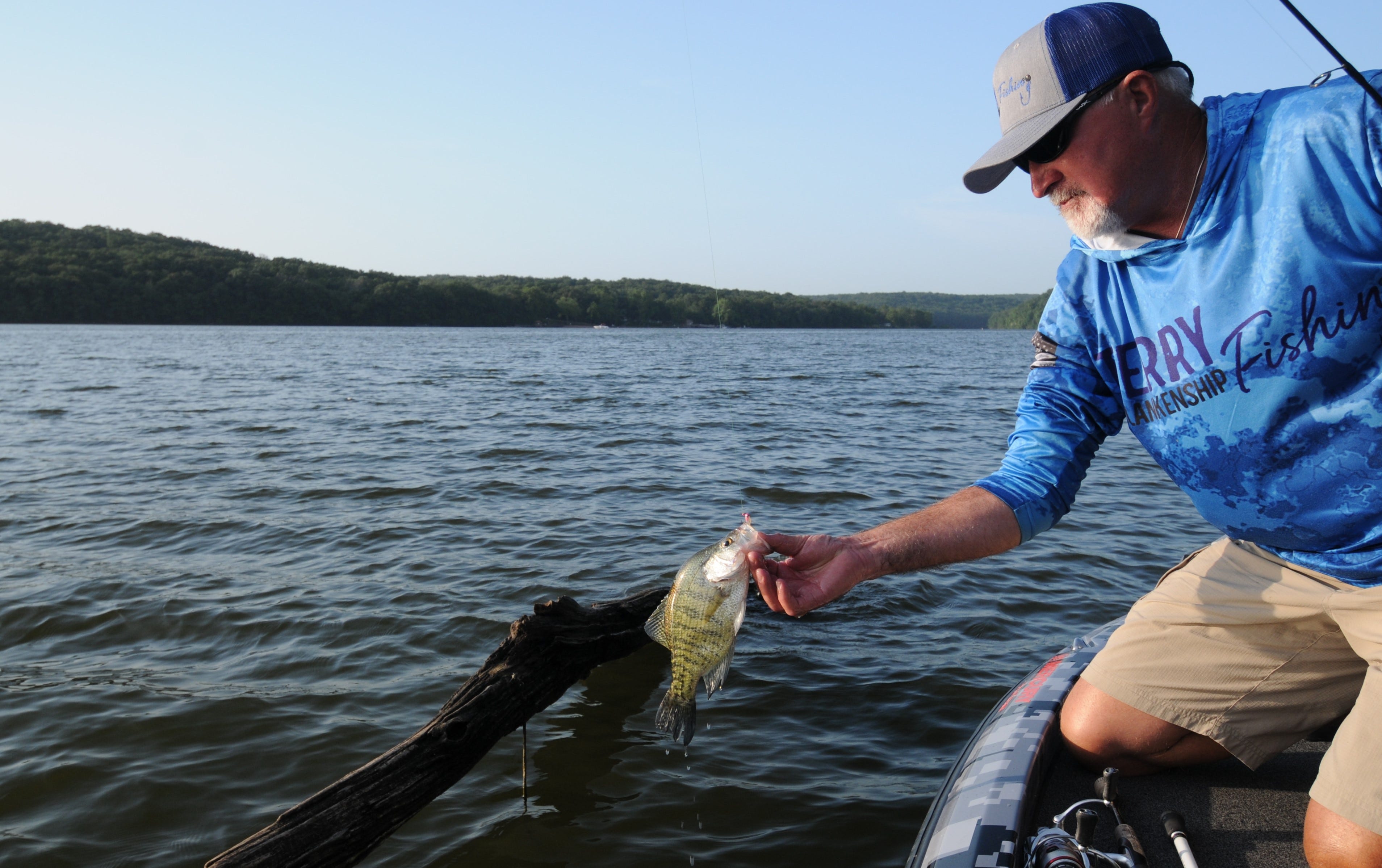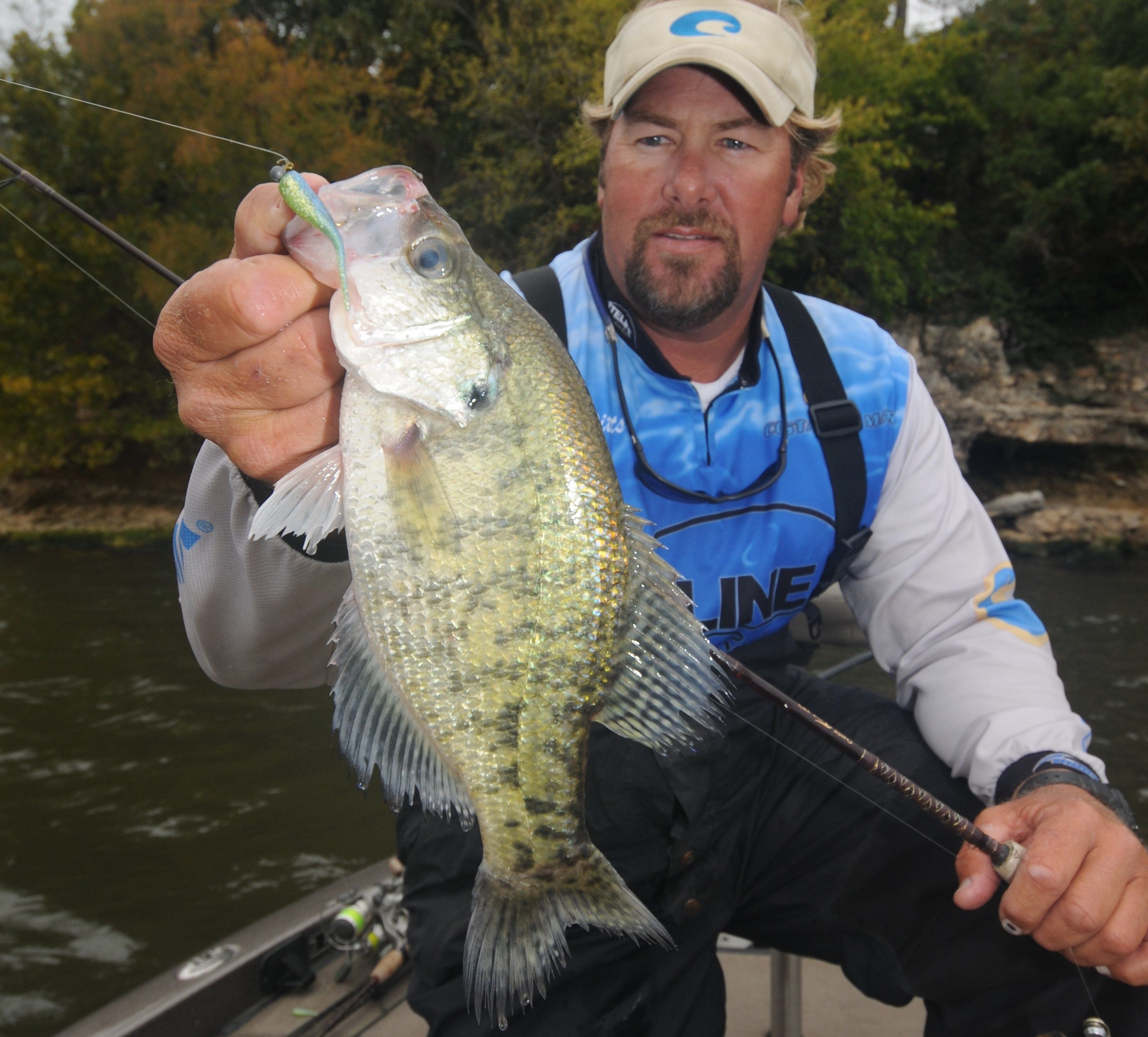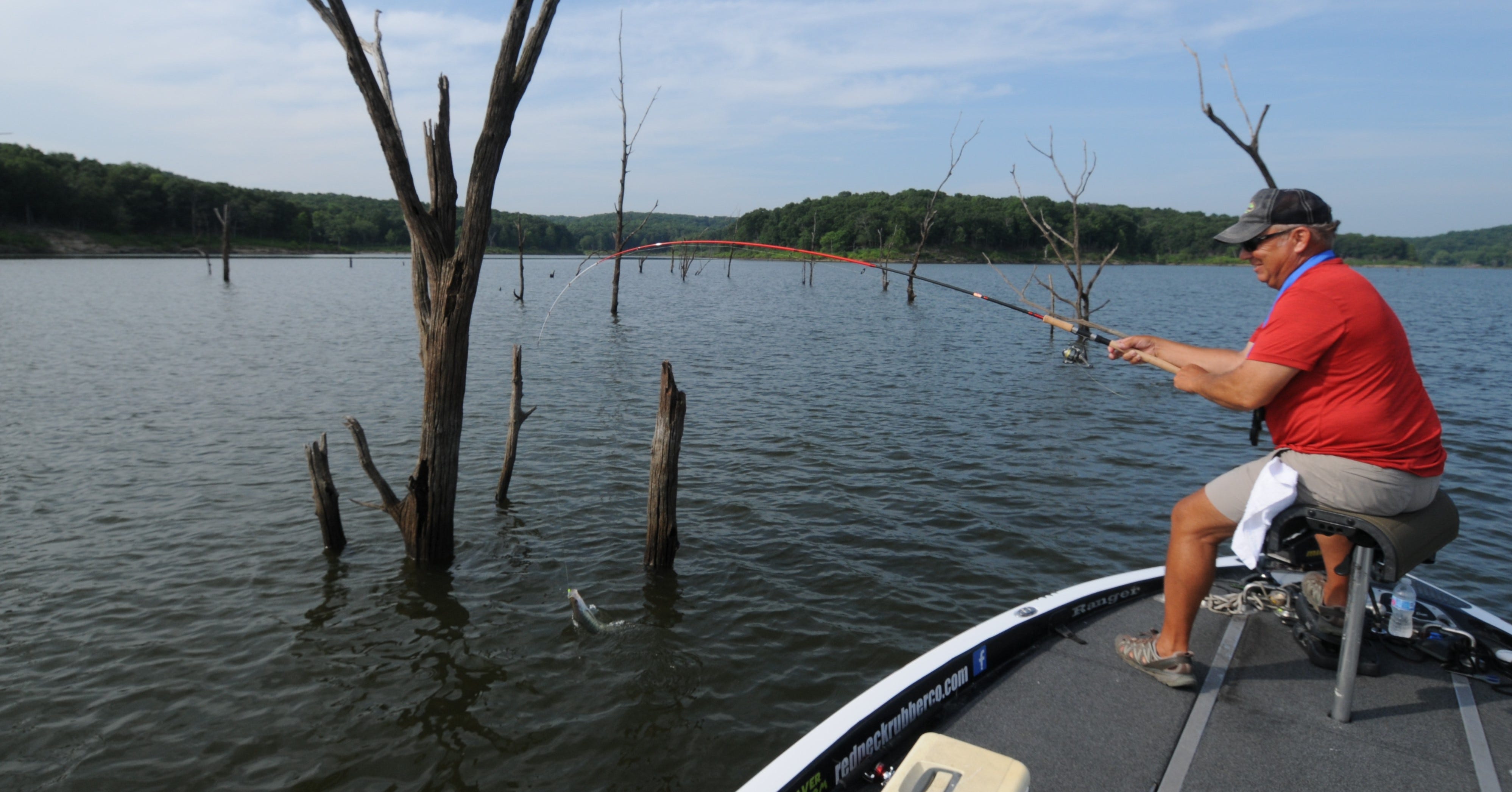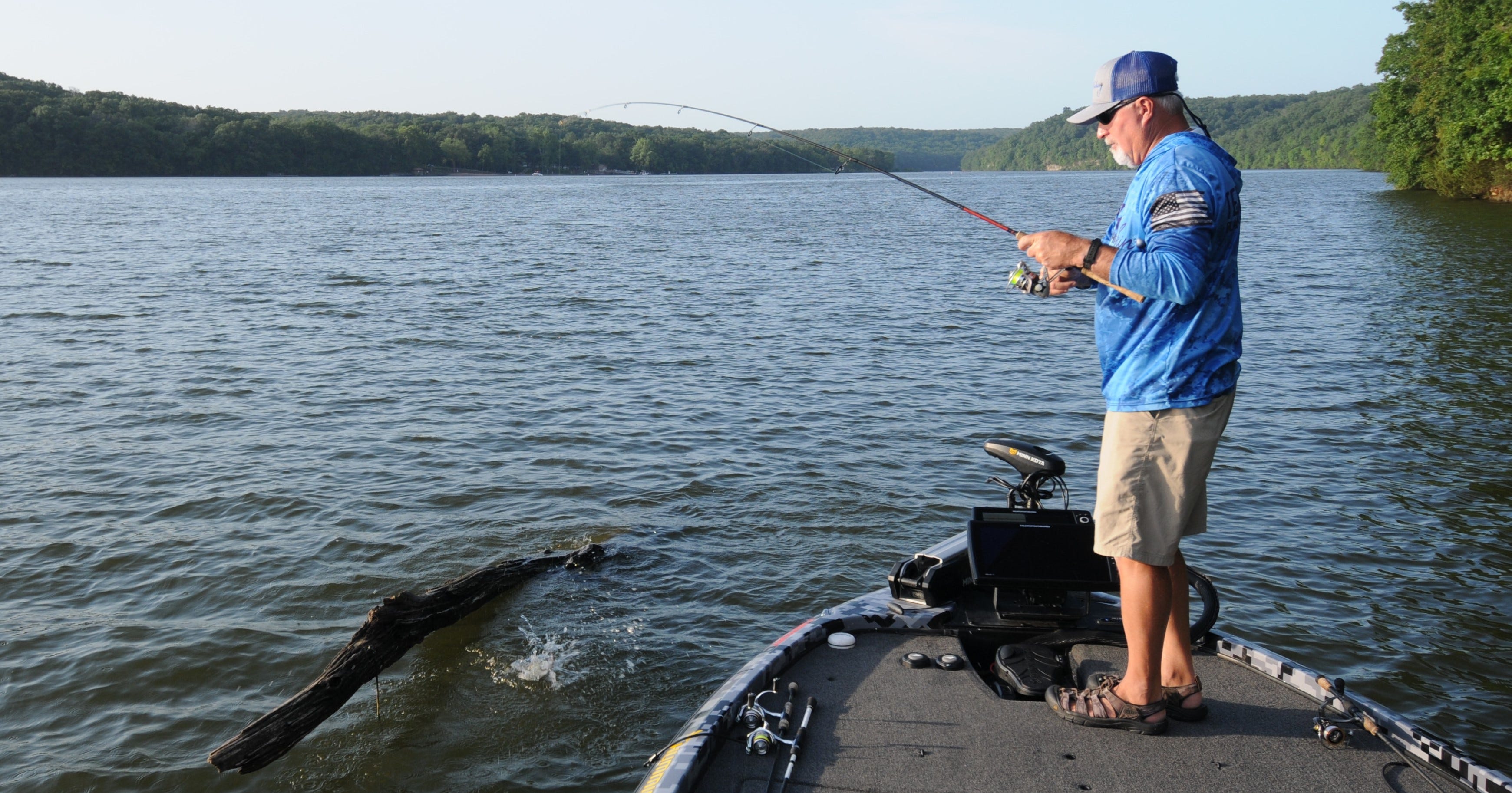- Aug 26, 2021
Vertical vs Horizontal for Shallow Summer Crappie
Savvy anglers know they can catch summertime crappie in the shallows with the right presentation. Read on and learn when to use which type of presentation.
When the summer heat is on, many crappie anglers head for deep water because they believe crappie go deep to seek the comfort of cooler water. While several anglers try vertical jigging techniques for deep crappie, four panfish experts head in the opposite direction to catch summertime crappie.
“That goes against some people’s beliefs that crappie go deep during the summertime, but they don’t because they are going to go where the baitfish are, and that is really the biggest key,” Lake of the Ozarks guide Terry Blankenship said. “They are just going to follow the bait.”
Blankenship and other veteran crappie anglers believe the presence of baitfish keep many crappie in the shallows, even in the scorching heat of summer.
“I have caught crappie in 3 feet of water during 100-degree weather,” said Oklahoma angler Gary Rowe. “A lot of times those shad will get real shallow, and as soon as they do, the crappie will follow.”
Here’s a look at how Alabama Guide Lee Pitts, Truman Lake Guide Barry Morrow (660-723-2667), Blankenship and Rowe catch shallow crappie during the heat of summer, using both horizontal and vertical presentations.
Logs & Laydowns


Rowe and Blankenship rely on a fading technique in which they pitch jigs to a visible log or laydown and let their lures descend parallel to the submerged part of the cover. This tactic allows them to present lures horizontally along most of the tree and then fish vertically along the deepest part of the cover.
Whether he is pitching to visible laydowns along the bank or submerged logs he finds with his Garmin Panoptix LiveScope, Rowe favors logs with some branches and big trunks. “The bigger the wood, the bigger the fish, most of the time,” he said. “The fish will position right underneath those branches.”
Rowe checks his Livescope to see how deep the fish are and then positions his boat 10 to 15 feet away from the log so he can make a horizontal presentation of swimming his jig along the cover. “I will throw past the log and let it go down to the depth I want t it to go to and then I will just do a real, real slow retrieve,” Rowe said.
Rowe’s favorite lure for the fading presentation is a Pearl White Bobby Garland Baby Shad Swim’R on a 1/16-ounce jighead. “The Baby Shad Swim’R has a real good tail on it that does a lot of action even if you are reeling it slow,” he said.
When crappie stop biting on his fading tactic, Rowe moves his boat over to the top of the log so he can make a vertical presentation with the same jig by holding it “dead still” next to the cover. “Usually that triggers some more bites,” he said.
“If I don’t get bit, then I will switch to a smaller bait – the Bobby Garland Itty Bit (Itty Bit Swim’R, Itty Bit Slab Slay’R or Itty Bit Slab Hunt’R) with a 1/64-ounce jighead, and I put a split shot above the lure to get it down quicker. For some reason crappie just cannot stand that Itty Bit, and they are going to eat it most of the time,” said Rowe. “A big portion of a crappie’s diet is real small stuff anyhow.”
The Itty Bit is Blankenship’s top choice for his fading technique because the lure matches the hatch of summertime shad. “The Itty Bit is designed to match the hatch,” Blankenship said. “In my area, around the first of July it is typical to see a shad hatch, and once I start seeing the fry in the water, I can tell they are not more than an inch or an inch and a half long. So the design of the Itty Bit makes it a perfect bait for the early hatch.”
Blankenship uses both the Itty Bit Swim’R and the Itty Bit Slab Slay’R (Blue Ice, Monkey Milk and Bluegrass) on a 1/32-ounce jighead. He usually relies on the Itty Bit Swim’R, but if crappie continue to nip the thin tail off the bait, Blankenship will switch to the Itty Bit Slab Slay'R to catch the short-striking fish. Using the 1/32-ounce jighead and supple 6-pound test line allows Blankenship to cast 25 to 30 feet for his horizontal presentation of the Itty Bit.
Blankenship scans the shallow log with his Humminbird 360 electronics to see how many crappie are holding on the log and the depth of the fish. He casts past the visible part of the log and counts down the lure as it falls and fades away from the visible cover. Counting down the lure helps Blankenship keep his Itty Bit above the crappie as it moves horizontally along the log.
The slow fall of the Itty Bit keeps the lure in the strike zone longer so Blankenship doesn’t have to impart any extra action. If crappie ignore his slow fall presentation, Blankenship will snap his lure with a slight flick of the wrist to trigger a reaction strike.
Blankenship’s fading technique employs both horizontal and vertical tactics. “You can make your cast and do your horizontal presentation, and as you are bringing the lure to you, you can slow your retrieve down to where the bait can fall almost straight below you and do your vertical presentation,” Blankenship said.
His Humminbird electronics unit comes into play when Blankenship watches his jig drop to the bottom and then raises his lure for his vertical presentation. “There have been many times where I have seen the fish will follow it all the way to the bottom and not hit but it will be staring at that bait,” Blankenship said. “Then all of a sudden I pop it off the bottom about a foot and hold it there. It is a great method for getting a strike.”
Stumps


Lee Pitts also employs the fading technique on horizontal logs, but he mainly targets stumps for his horizontal and vertical presentations in shallow water.
“Most of the time in the summer the vertical approach is what you are really going to be using because you are putting it in that strike zone and more or less aggravating crappie into biting,” Pitts said. The Alabama pro favors a vertical presentation for fishing laydowns with multiple branches, bridge pilings and brush piles.
When vertical jigging, Pitts positions his boat over the cover and drops his jig to the depth of the crappie he sees on his Humminbird unit. Holding his jig still during his vertical presentation is the key to triggering strikes from lethargic summertime crappie, so Pitts’ favorite lures for this tactic are the Baby Shad Swim’R, 2-inch Slab Slayer and Minnow Mind’R, which all have lively tails that generate a lot of action with little or no rod movement.
“I can still get good action out of those baits with the way the tails are designed,” he said. “Just a little bit of movement gives that bait a whole lot of quiver and shake to it.”
Pitts’ favorite colors include Monkey Milk, Black Chartreuse, Cajun Cricket and Bluegrass. He fishes vertically with a 1/24-ounce jighead most of the time and will add a split shot for extra weight if he is contending with a strong current or heavy wind.
A horizontal approach followed by a vertical presentation works best for Pitts when he is targeting shallow stumps in the summertime. He uses the same lures for fishing the stumps as he does for his other vertical presentations, with a 1/24-ounce jighead, which he upgrades to a 1/8-ounce model if he is fishing in a strong current.
Pitts positions his boat within pitching distance of the stumps and delivers his jig to the cover. As the lure falls Pitts keeps a bow in his line and watches for any movement in the line, indicating a strike. He slowly swims the lure through the stumps and gives it an occasional twitch while swimming it or after he feels it hit the cover.
If his horizontal approach fails to trigger a strike, Pitts moves closer to the stump and subtly vertical jigs the cover. “You don’t have to move it a lot. It may be just a subtle little flick of the wrist,” Pitts said. “I will even sometimes just hold it out there and get it in the strike zone where I am feeling that stump. I may hold that line with my free hand and more or less thump that line to where it is not moving it much but it is just enough that it is a little quiver.”
Standing timber


Truman Lake Guide Barry Morrow targets standing timber to catch shallow summertime crappie from his home waters. He finds these shallow panfish hanging around either clusters of hardwood hedge trees or single cedar trees.
When fishing the hardwoods Morrow combines horizontal and vertical presentations using smaller baits such as the 2-inch Slab Slay’R, Baby Shad and Crappie Shooter to match the size of the shad or insects at that time of the year. Favored colors include Black Chartreuse, Pearl Chartreuse, Bluegrass and Tadpole. He impales the lures on jigheads ranging in size from 3/32 to 1/4 ounce.
“I pitch past the tree, so the jig is coming down into the water at an angle, which is like an insect landing on the water, so that entices a bite,” Morrow said. He lets the jig pendulum back toward the boat until it passes about a foot away from the cover and then reels it in to make a pitch to another tree in the cluster.
If his horizontal approach fails to entice a bite, Morrow moves his boat closer to the middle of the cluster and slowly drops his jig into the shady area to vertical jig. He describes his presentation as “pretty much dead sticking” the lure at depths as shallow as 3 to 4 feet.
A vertical presentation with a 2-inch Slab Slay’R or Baby Shad on a 1/8-ounce jig works best for Morrow when he targets shallow cedar trees. He dips jigs around the edges of the cedars first to catch any bigger fish from the outside limbs. His next move is to find an opening in the branches so he can fish his jig close to the cedar’s trunk.
“I pull my jighead all the way to the eye next to the rod tip and then I poke my jig pole into the tree as close to the trunk as I can get in one of those openings and then I just let it drop real slow,” Morrow said of his vertical presentation. “I twitch my pole to jig the bait all the way down and bounce it off the limbs.”
Morrow notes the key to this presentation is to keep a tight line as the jig falls so the weight of the jig will bounce off the limbs and prevent hang-ups. When the jig hits the bottom, Morrow lifts the lure about a foot to catch any crappie holding near the trunk. After dead sticking the jig for a while, Morrow slowly lifts the jig toward the surface to trigger bites from any crappie hanging around the inner limbs.
Luring Crappie to Your Boat


Terry Blankenship has discovered crappie will come to him if he keeps his boat near shallow cover long enough. The Missouri guide has noticed shallow crappie will leave the cover and start hanging under his boat where he catches them with a vertical jigging presentation. Here are some pointers from Blankenship on how you can lure shallow crappie to your boat:
- Your boat casts shade similar to a boat dock, so crappie will seek the larger shady comfort zone of your boat instead of the log you were fishing.
- Crappie move to the shade of the boat best on sunny days. Cloudy days will cause the fish to scatter around the shallow cover.
- Crappie will start congregating under the boat within five to 10 minutes of fishing next to the shallow cover.
- Try vertical jigging higher in the water column because crappie will sometimes suspend within a couple of feet of the boat’s hull.
- The shady side of the boat parallel to the shallow cover will be the sweet spot to fish for crappie hanging under the boat.



